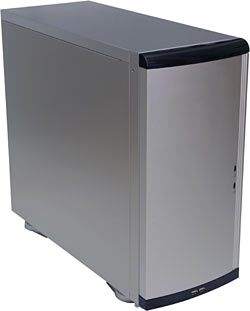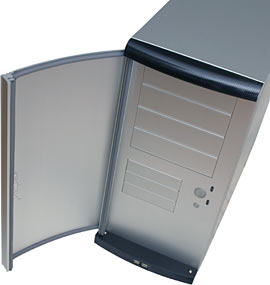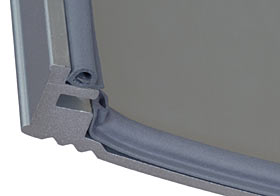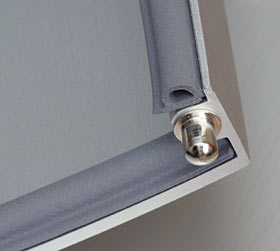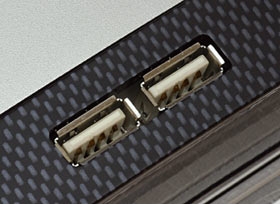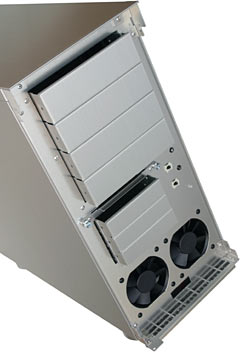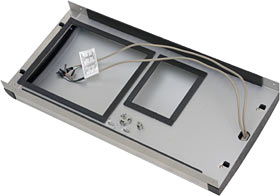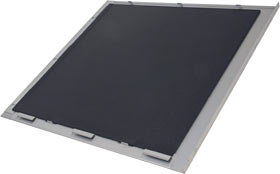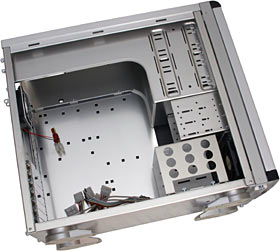
Lian Li PC-6070 computer case
Review date: 25 July 2003.Last modified 03-Dec-2011.
Quiet, well-cooled PCs are hard to come by.
All ordinary PCs are cooled by fans that shove air through their cases, and fans make noise. You can get around this problem by using cool-running hardware, but if you want to be somewhere vaguely close to the cutting edge of PC performance, you've got to put up with some noise.
Lian Li make a lot of PC cases, most of which have three or four 80mm fans factory-installed. They don't come with a Power Supply Unit (PSU), either; add a PSU and you get at least one more fan. And then there's the fan on the CPU cooler (well, maybe not), and probably another fan on the video card, and commonly another fan on the motherboard north bridge chip, though those last two are likely to be tiny and pretty quiet.
Modern PCs don't contain much that makes noise besides the fans. Hard drives, yes, but many of those are very quiet these days. Optical drives, sure; fast CD and DVD drives can make quite a racket when they're spinning an unbalanced disc. But optical drives aren't spinning all the time. Most PC noise still comes from fans.
I wasn't, therefore, especially optimistic about Lian Li's PC-6070 low noise case. It's meant to be quieter than their usual products, and it's got some extras to help - a solid aluminium door with a rubber gasket around it, and sound-deadening foam on the inside of its side and top panels. But the PC-6070 still has two front fans and one rear one, and it doesn't muffle those any more than various other Lian Lis do.
(I got a "PC-6070A" for review, by the way, not a PC-6070; Lian Li's Japanese site has a page for this version of the case, but it seems to be exactly the same as the regular PC-6070, as far as I can tell.)
As it turned out, though, this actually is a rather quiet case. But it cheats a bit.
On with the show.
Inside and out
The PC-6070's front panel certainly makes an impression. With the door closed, this case presents a smoothly curved wall of aluminium to the world, punctuated only by a couple of light guides for the power and drive activity lights.
The PC-6070's door makes it a bit deeper than Lian Li's usual midi-towers; it's the same 210mm wide by 460mm high (counting the swing-out feet on the bottom), but it's 525mm deep. That's 8.3 by 18.1 by 20.7 inches.
Above and below the door, there are matching curved segments of Lian Li's trademark glossy fake carbon fibre. Peer at it closely enough and you can see that it's paint, not real carbon weave, but from normal viewing distances it looks convincing.
The door doesn't have a lock. It's held closed by a spring loaded ball bearing catch, which doesn't hold it very hard; tip the case forward and the door will swing open. So if you're transporting a PC-6070, you should put a bit of tape on the door.
Despite this, the weight of the door's sufficient that an ejecting CD or DVD drive isn't likely to be able to push it open.
Note that the power and drive activity "lights" on the panel under the door are, themselves, light guides; they're clear plastic pegs that point at the actual LEDs on the case's real front panel underneath. The "lights" on the door are a second set of light guides, so they're quite a bit dimmer. Lian Li use high intensity LEDs for their case lights, though, so these things are still pretty bright, even through stacked light guides.
The insides of the door are trimmed with this soft foam edging, which stops the door from rattling against the case. The vibration isolation provided by the edging also, presumably, helps reduce radiated noise a bit, beyond obvious buzz-stopping. Vibrating panels can emit a significant racket from a PC with some unbalanced fans or optical drives in it. This door's so heavy already, though, that I doubt it needs anything beyond a simple buzz-stopper.
The first thing I noticed about my review PC-6070's door is that it doesn't quite fit properly. The bottom right corner of the door strikes the bottom piece of "carbon fibre" trim; you have to lift the door a bit to get it to close properly. This isn't entirely surprising, given how heavy the door is, but Lian Li cases usually have excellent fit and finish I expected better from them.
Fortunately, this problem is solvable.
At the top of the door, there's this little lever sticking down. Push it to the left and the hinge peg that retains the top of the door retracts, allowing you to remove the door entirely...
...and giving you access to the hinge peg that sticks out of the bottom of the door.
If you put a washer on this peg - nylon or some similarly non-abrasive material, by preference - you'll shim the door hinge upwards, and it'll close properly. I haven't tried this with an actual washer, but I made a proof-of-concept attempt with a highly scientific piece of folded paper with a hole stabbed through it, and that did the trick just fine. While you're looking for a suitable washer, you could use a hole-punched piece of cardboard.
I wouldn't be surprised, by the way, if many other PC-6070s didn't have this problem in the first place. But if yours does, it's not worth panicking over, and certainly not worth the trouble of getting a warranty replacement. Just don't open and close the door over and over if it doesn't fit properly and you haven't fixed it yet, or you'll gouge the trim.
Below the possibly-troublesome front trim, there's a slim perforated grille, secured with a couple of Lian Li's usual thumbscrews; it covers the foam air filter for the front fans.
Lian Li have used this style of fan filter on previous PC-60xx series cases. It's not nearly as big as the straight-through front filter that most of their cases use, and it faces the dusty floor, but it does help keep the fans quiet.
The PC-6070 has a sensible pair of USB ports (USB 2.0 compatible), embedded in the bottom trim strip, as its only front connectors. This is fine, because it's all you're likely to need, or use. People whose cases have four front USB ports often only use two of them, because there's nowhere to plug the other two in. If all four of them are connected, two will probably be using inelegant loopback cables and taking up ports on the back of the case.
The front ports are, of course, USB 2.0 (or "Hi-Speed USB", or whatever) capable. If there's a difference between the wiring specs for USB 2.0 and 1.1, I don't know what it is; pretty every front-ported case should work fine at USB 2 speed.
If you want to remove the PC-6070's front panel and door assembly, you can't just pull on it. Pretty much every other somewhat recent Lian Li case has simple clips for the front panel, but the PC-6070 assembly's so heavy that it'd need a phalanx of clips to hold it on. Instead, Lian Li have used four little countersunk screws.
Remove them and slide off the rather tight panel assembly (better tight and awkward than loose and rattly...), and you can see the case's real front. There's the little fan filter, down at the bottom.
This is a pretty standard Lian Li front, down to the removable middle 3.5 inch drive cage, which is retained with three thumbscrews. That cage is the only reason why most people would ever want to take the front panel assembly off the PC-6070, except perhaps to get easier access to the 5.25 inch bays when installing drives. The front bay covers aren't screwed in place, though, and you don't have to pull them out to install a drive; you can just push them into the case. There's nothing else here that regular users need to bother with.
Notably, there's no three-position fan speed switch, as seen on most PC-6x-series cases. This is a bit surprising; if the fans run at full speed all the time, you'd expect the PC-6070 to be almost as loud as a regular midi-tower Lian Li with its fan controller set to full speed.
It isn't, though, because it's got quieter fans. They're Adda 80mm units, as usual for Lian Li, but these ones only have a 0.09 amp run power rating. That, for an 80mm fan, is minuscule; 1.08 watts rated power, and probably significantly less than one watt after they've spun up and the motors have settled to their cruising speed.
The usual Lian Li fans aren't high power units, but they do at least have a 0.15 amp rating; five-thirds the power of the PC-6070 fans.
The speed control switches on Lian Li cases use simple inline resistors, so their effect on the fans they're connected to varies depending on how powerful those fans are. With the stock 0.15 amp fans, you get roughly two-thirds and roughly two-fifths power, for the two lower speed settings. This means the medium speed setting on a PC-60-type case probably gives about the same front-fan air moving power as the PC-6070 has already.
The PC-6070 is quieter, though, because it's only got three stock fans, not the four that many Lian Lis now have, and all three of them are low speed units. There's no speed control for the rear or top fans on Lian Li cases.
The PC-6070 fans also, by the way, have ball bearings instead of the sleeve bearings on the 0.15 amp fans. That doesn't make much difference to anything, though; fans this slow should last for years on end no matter what bearing type they use, and ball bearings don't make a fan significantly quieter.
The PC-6070's quiet fans move less air than the louder fans in other Lian Li cases, as you'd expect. But between the three factory-installed ones and whatever fan your PSU adds, you still ought to get plenty of ventilation. If you forget to clean the PC-6070's slim front fan filter then you might have issues, though; if you think you'll be forgetful, you could just remove the foam filter entirely and put up with a computer that slowly fills itself with dust.
Here's the front door and panel assembly, viewed from behind. There's more cushioning sealant foam around the edges and around the drive bay areas, and you can also see the two cables for the front USB ports. As usual for Lian Li, these terminate in two sets of four single-pin micro-plugs, which mean you can connect them to any motherboard that has USB port headers on it, provided your mobo manual tells you what the pinout is. Lian Li have helpfully attached an explanatory paper tag to one of the leads, but that doesn't tell you about your motherboard pinout.
At the back of the PC-6070, there are the standard Lian Li midi-tower luxuries. A removable plate for PSU mounting so you don't have to thread the PSU through from the inside, a slide-out motherboard tray, the third stock fan, and a bunch of thumbscrews holding everything together. There are also a couple of drilled tabs that let you padlock the case side and motherboard tray in place. The tabs are only aluminium, though, so this isn't exactly a secret research facility level of security.
The PC-6070 side panels slide off like every other Lian Li's, except they're a bit of a tight fit. This could be an anti-rattle feature, or a result of the foam on the inside, or just a coincidence. Anyway...
...they look like this.
The foam is only three millimetres thick, and isn't heavy either You can buy super-dense metal-loaded sound damping foam, but this isn't it. The foam does a decent job of stopping the thin aluminium panel from ringing like a gong, though.
Flat thin foam like this doesn't absorb very much sound. If you want to do that, you need proper "egg carton" acoustic foam tiles.
Inside, the PC-6070 is standard Lian Li again. Which is to say, very nice - just not too exciting for a battle-hardened Lian Li veteran like me.
Along with the four externally accessible 5.25 inch bays and the three externally accessible 3.5 inch bays in the centre cage, this case has one of Lian Li's easily removed vertical-mount five drive 3.5 inch cages at the bottom front, right behind the intake fans. You'll lose quite a lot of airflow if you install more than three drives in this cage, but that ought to be more than enough for most users.
The bottom drive cage, by the way, has three standard sets of horizontal drive mounting slots in one side of it, and the PC-6070 comes with an extra piece of aluminium that you can slide into the other side of the cage and fasten with three screws, to provide appropriately positioned slots on the other side.
I'm not sure why you'd want to do this, though; there's not much point to converting a five drive vertical mount cage into a three drive horizontal mount one. Modern hard drives are perfectly happy mounted vertically, and you'll get more air space between three drives if you install them in vertical slots 1, 3 and 5.
The PC-6070 also has the handy one-piece connector in the middle of all the fiddly case switch and LED wires, which lets you slide the motherboard tray out without unplugging and replugging all of those tiny wires. There's no similar connector in the USB port cables, though; those, you have to replug.
All three of the PC-6070's fans run from four-pin passthrough power connectors, so you don't need any extra PSU plugs to run them. You can't monitor the speed of any of the case fans, though; they're basic two-wire units.
Listening to it
The PC-6070 is a quiet case, and not just by Lian Li standards. Those three low power fans are quieter all put together than the single fan in most PSUs.
The front door does something to quiet the case, as well; PCs do emit a fair bit of sound through the front panel, and sealing it all up and putting it behind a slab of aluminium helps noticeably.
The foam on the side and top panels doesn't seem to do very much more to quiet the case. You can't expect much from light flat foam that's this thin.
How loud a PC-6070-based computer will actually sound to you depends, of course, largely on what other components you put in it. Forward-exiting sound from drives should be muffled considerably by the front door, but the PC-6070's sides aren't any quieter than the heavier sides of a quality steel case. Install a screaming overclockers' CPU cooler and a multi-fan PSU, and a PC-6070 machine won't be particularly shy and retiring.
You can reduce noise further without serious case mods, though. The biggest change you can make isn't inside the case at all - it's something to catch the noise coming out of the back of the box, to stop it bouncing off the wall that's probably behind your PC and, thence, making its way to your ears.
A folded blanket will do a reasonable job here, but egg-carton foam is better. Here in Australia, you can get acoustic foam tiles in mated sets of two from Jaycar; stock code AX3652 for the $AU15-for-two 25mm thick tiles, and stock code AX3656 for the superior $AU22.50-for-two 38mm thick version. The tiles are 30cm square, so one pair should be enough for the patch of wall behind a computer.
If you've got some more tiles, you could stick them inside the case as well, but there's a limit to how much extra sound insulation you'll be able to fit in there. A thin tile should fit OK on the most commonly removed side of the case (the left side, as you look at the case from the front), and you could cram some in on the bottom and top panels as well, but there's very little room between the motherboard tray and the right side, and pretty much no foam-mounting opportunities on the back panel.
Cooling
The foam lining on the PC-6070's panels will, in theory, reduce its ability to get rid of heat from the components inside. Aluminium case manufacturers like to mention aluminium's superior thermal conductivity compared with steel, and the foam pads block heat as well as sound.
In the real world, though, conduction accounts for very little of the cooling ability of a case. The fans do almost all of the work, as anybody whose computer's cooling fans have all died will be able to tell you, right after they finish frying their breakfast on the top of the box.
The PC-6070's slow fans and small front fan filter will have much more impact on its cooling capabilities. It should still do about as well as a PC-6x case with its fans set to minimum speed, though.
Overall
As I write this, Aus PC Market have the plain vanilla silver aluminium Lian Li PC-60USB case on special for only $AU242, including Sydney delivery (delivery to other parts of Australia costs more). The PC-6070 isn't on special; it costs $AU357.50.
(Neither of these prices includes a power supply, remember.)
If you want a fast PC in a good-sized case that's easy to work on and looks great, and less computer noise is worth around a hundred bucks to you, then the PC-6070 is a decent deal even compared with the reduced-price PC-60USB.
It's not a great deal, though. The PC-60USB has speed controllable front fans, and you can replace its other fans with slower ones, or apply after-market speed controls to them. You can also stick foam in and behind a PC-60 just as you can with the PC-6070. All the PC-60 really lacks is the metal-slab front door.
And the PC-6070 isn't going to give you a silent PC, even if you do add more deadening material to it.
So, for most people's purposes, I think the PC-60's still the better buy. The PC-60 design hasn't changed a great deal in the three years since I first reviewed one, and the things still sell well, for good reason. At less than $AU250 (or a bit more, if you live in an out-of-the-way place...), the PC-60USB is a very good deal.
Even if you don't particularly care about quietness, though, the slab-fronted PC-6070 has its own distinct aesthetic. If the wall-of-aluminium look turns you on, go for it; it's not that much more expensive, compared with the price of all the other stuff that goes to make up a PC.
Buy stuff!
Aus PC Market no longer sell the PC-6070, but they've got lots of
other Lian Lis, including the newer low-noise model, the
PC-S80.
(if you're not in Australia or New Zealand,
Aus PC Market won't deliver to you. If you're in the USA, try a price search
at
DealTime!)
